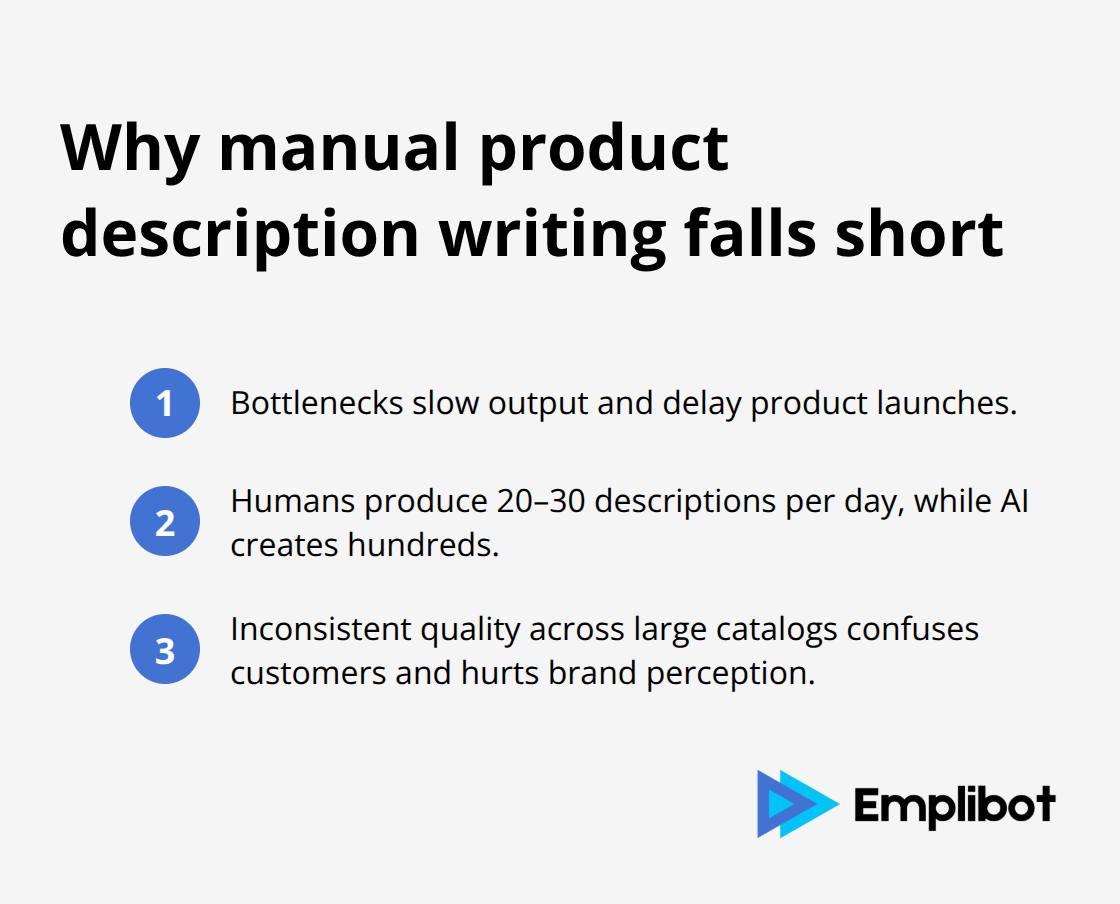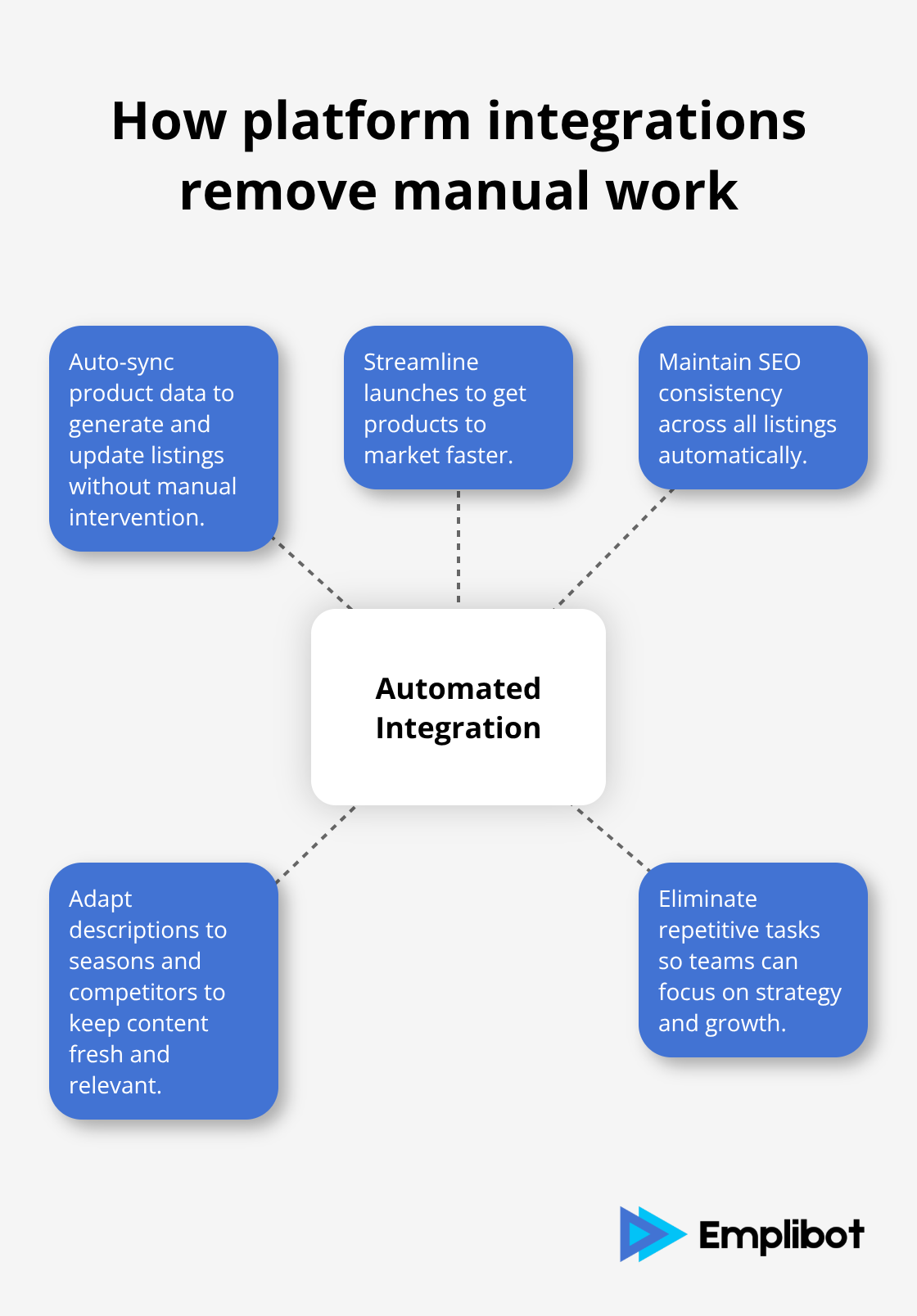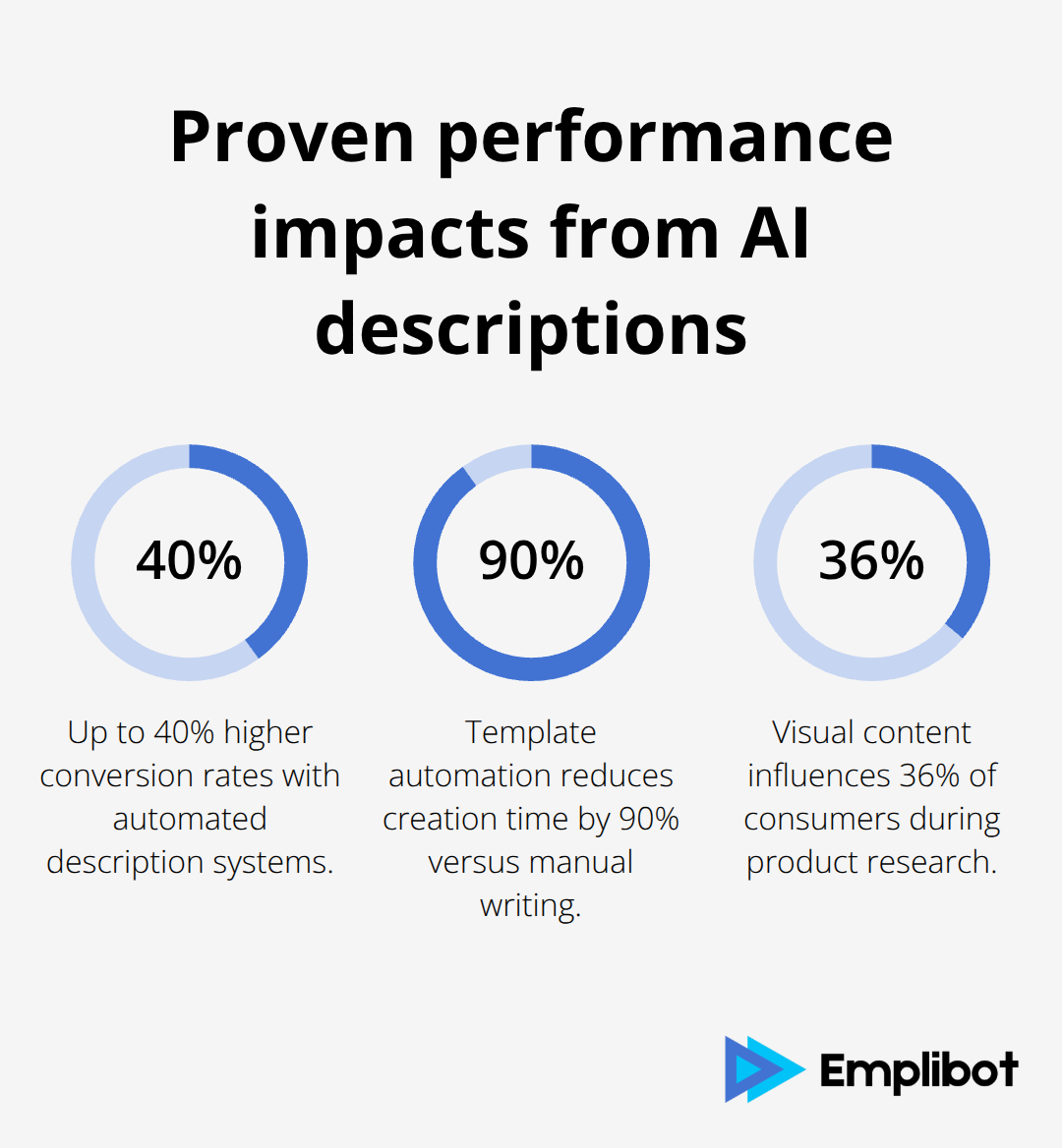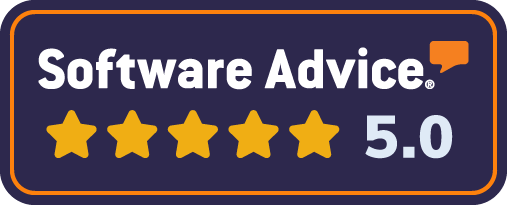Writing product descriptions manually takes hours and often produces inconsistent results. Most e-commerce businesses struggle to create compelling copy that converts visitors into buyers.
Auto-generate product descriptions using AI technology can solve this problem while boosting sales. We at Emplibot have seen businesses increase their conversion rates by up to 40% with automated description systems.
Contents
ToggleWhat Makes Auto-Generated Product Descriptions Actually Work
Auto-generation technology transforms basic product data into persuasive sales copy through advanced natural language processing algorithms. These systems analyze product specifications, competitor descriptions, and successful sales patterns to create content that converts browsers into buyers. According to research, consumers rely heavily on product descriptions to make purchase decisions, which makes automated generation a game-changer for e-commerce businesses that manage hundreds or thousands of products.
The Technology Behind High-Converting Descriptions
Modern AI systems excel at identification of which product features matter most to customers and transformation of technical specifications into compelling benefits. The technology processes product images, specifications, and category data to generate descriptions that highlight unique selling points while it maintains SEO optimization. With conversion rates averaging under 2% across e-commerce sites, AI-powered generators help businesses optimize their product content consistently across entire product catalogs.
Why Manual Writing Falls Short for Modern E-commerce
Manual description writing creates bottlenecks that cost businesses thousands in lost sales opportunities. A single copywriter might produce 20-30 quality descriptions per day, while AI systems generate hundreds of optimized descriptions in the same timeframe. Human writers struggle with consistency across large product catalogs, which leads to varying quality levels that confuse customers and hurt brand perception.

Integration Capabilities That Scale Your Business
These systems integrate seamlessly with platforms like Shopify and WooCommerce (automatically updating listings as inventory changes). Automated systems maintain uniform brand voice, incorporate proven sales psychology principles, and optimize for search engines without the fatigue and inconsistency that plague manual processes. The technology handles bulk processing for thousands of products simultaneously, which eliminates the resource constraints that limit traditional copywriting approaches.
Now that you understand how auto-generation technology works and why it outperforms manual methods, let’s explore the specific tools and platforms available to implement this solution in your business.
Which Tools Generate Product Descriptions That Actually Convert
AI-powered platforms dominate the product description generation space because they produce consistently high-converting copy at scale. Copy.ai leads the market with its specialized e-commerce templates that transform product specifications into benefit-focused descriptions, while Ahrefs Product Description Generator excels at SEO optimization and automatically incorporates relevant keywords based on search data. These platforms use natural language processing trained on millions of successful product pages, which means they understand conversion psychology better than most human copywriters. These AI tools help businesses create more effective product descriptions that drive better engagement and sales performance.
Template Systems That Scale Without Quality Loss
Template-based systems work best for businesses with consistent product categories because they maintain brand voice while they adapt to different product attributes. Numerous.AI integrates directly with Google Sheets and Excel, which allows businesses to generate thousands of descriptions simultaneously through spreadsheet automation. This approach reduces description creation time by 90% compared to manual writing while it maintains consistency across entire product catalogs. The system analyzes successful competitor descriptions and incorporates proven sales language patterns (which eliminates the guesswork from copywriting). Template systems particularly excel for fashion, electronics, and home goods retailers where product attributes follow predictable patterns.
Platform Integration That Eliminates Manual Work
Direct integration with e-commerce platforms like Shopify and WooCommerce transforms product description generation from a time-consuming task into an automated process. These integrations automatically pull product data, generate optimized descriptions, and update listings without manual intervention. Integrated systems streamline the product launch process and help businesses get products to market more efficiently. The integration maintains SEO optimization across all listings while it adapts descriptions based on seasonal trends and competitor analysis (which keeps content fresh and relevant without manual effort).

Free vs Premium Tool Options
Free AI product description generators serve as excellent starting points for small businesses that want to experiment with automated content creation before they commit to premium solutions. These basic tools handle simple product categories effectively but lack the advanced customization and bulk processing capabilities that larger retailers need. Premium platforms offer sophisticated features like A/B testing capabilities, multi-language support, and advanced SEO optimization that can boost conversion rates significantly. The investment in premium tools typically pays for itself within 60-90 days through improved conversion rates and reduced content creation costs.
Now that you understand which tools can transform your product description process, the next step involves implementing best practices that maximize conversion rates and search visibility.
How to Write Descriptions That Convert Browsers Into Buyers
Product descriptions that convert focus ruthlessly on customer benefits rather than technical specifications because shoppers care about solutions, not features. A smartphone description that lists megapixels and processor speeds converts poorly compared to one that promises crystal-clear photos of family moments and lightning-fast app performance. Research from eMarketer shows that visual content influences 36% of consumers when researching products. Transform every product feature into a customer benefit when you ask what problem it solves or what desire it fulfills. Instead of waterproof IPX7, write stays protected during beach trips and poolside relaxation.
Strategic Keyword Placement Without Spam
Search optimization requires strategic keyword placement that feels natural while it boosts visibility on Google and Amazon. Tools like Ahrefs help identify high-conversion keywords that customers actually search for when they want your products. Place primary keywords in the first 160 characters because search engines prioritize early content placement, but avoid keyword spam that makes descriptions sound robotic. Long-tail keywords like wireless noise-cancellation headphones for travel convert better than generic terms like headphones because they match specific customer intent. Successful e-commerce sites integrate 2-3 relevant keywords per description while they maintain readability (which balances search visibility with conversion psychology).
Brand Voice Automation That Builds Trust
Consistent brand voice across thousands of product descriptions builds customer trust and recognition, but manual content creates inevitable inconsistencies that confuse shoppers. AI systems excel at maintenance of predetermined tone guidelines whether your brand speaks casually or professionally, technically or emotionally. Configure your automated system with specific language patterns, prohibited words, and required phrases that reflect your brand personality. Premium retailers maintain luxury position through sophisticated language choices, while direct-to-consumer brands use conversational tone that builds personal connections. Test different voice variations through A/B tests to identify which tone creates higher conversion rates for your specific audience and product categories.
Scannable Format That Increases Readability
Structure descriptions with headings, bullet points, and short sentences because customers scan rather than read product pages. Break dense paragraphs into digestible chunks that highlight key benefits and features separately. Use bullet points for technical specifications while you reserve paragraph text for emotional benefits and use cases. White space improves readability significantly and readability research shows the connection between caption readability and user engagement. Format descriptions consistently across your catalog to create predictable user experience that builds customer confidence and reduces bounce rates.
Final Thoughts
AI systems that auto-generate product descriptions eliminate manual bottlenecks and boost conversion rates up to 40%. Businesses save hundreds of hours monthly while they maintain consistent brand voice across thousands of products. The technology scales effortlessly from small catalogs to enterprise-level inventories.

Success requires selection of the right AI platform for your product categories and integration with your e-commerce system. Configure brand voice guidelines, test different description formats, and monitor performance metrics to optimize results. Most businesses see positive ROI within 60-90 days through improved conversion rates and reduced content creation costs (which typically pays for the initial investment).
Companies that implement automated description systems gain competitive advantages in speed-to-market and content quality consistency. The investment delivers increased search visibility, higher customer engagement, and streamlined product launches. For businesses that manage extensive product catalogs, automated content marketing solutions like Emplibot provide comprehensive automation that extends beyond product descriptions to full content marketing strategies.










